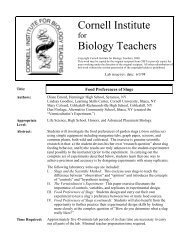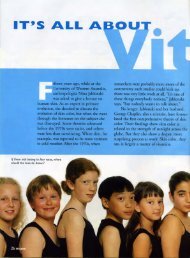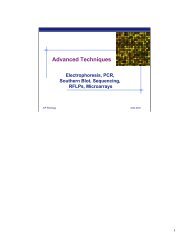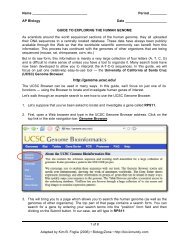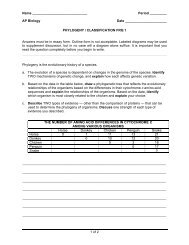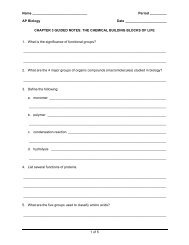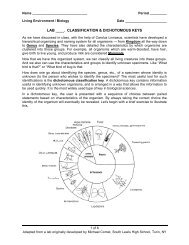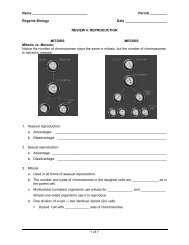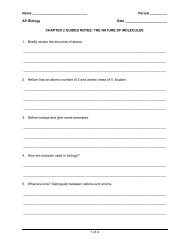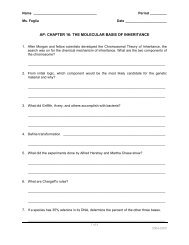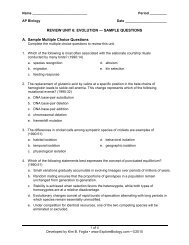Effects of Drugs on Pulsation Rate of Lumbriculus variegatus ...
Effects of Drugs on Pulsation Rate of Lumbriculus variegatus ...
Effects of Drugs on Pulsation Rate of Lumbriculus variegatus ...
Create successful ePaper yourself
Turn your PDF publications into a flip-book with our unique Google optimized e-Paper software.
This article reprinted from:<br />
Bohrer, K.E. 2006. <str<strong>on</strong>g>Effects</str<strong>on</strong>g> <str<strong>on</strong>g>of</str<strong>on</strong>g> drugs <strong>on</strong> pulsati<strong>on</strong> rate <str<strong>on</strong>g>of</str<strong>on</strong>g> <strong>Lumbriculus</strong> <strong>variegatus</strong><br />
(blackworms). Pages 127-146, in Tested Studies for Laboratory Teaching, Volume 27<br />
(M.A. O'D<strong>on</strong>nell, Editor). Proceedings <str<strong>on</strong>g>of</str<strong>on</strong>g> the 27th Workshop/C<strong>on</strong>ference <str<strong>on</strong>g>of</str<strong>on</strong>g> the<br />
Associati<strong>on</strong> for Biology Laboratory Educati<strong>on</strong> (ABLE), 383 pages.<br />
Compilati<strong>on</strong> copyright © 2006 by the Associati<strong>on</strong> for Biology Laboratory Educati<strong>on</strong> (ABLE)<br />
ISBN 1-890444-09-X<br />
All rights reserved. No part <str<strong>on</strong>g>of</str<strong>on</strong>g> this publicati<strong>on</strong> may be reproduced, stored in a retrieval system, or<br />
transmitted, in any form or by any means, electr<strong>on</strong>ic, mechanical, photocopying, recording, or otherwise,<br />
without the prior written permissi<strong>on</strong> <str<strong>on</strong>g>of</str<strong>on</strong>g> the copyright owner. Use solely at <strong>on</strong>e’s own instituti<strong>on</strong> with no<br />
intent for pr<str<strong>on</strong>g>of</str<strong>on</strong>g>it is excluded from the preceding copyright restricti<strong>on</strong>, unless otherwise noted <strong>on</strong> the<br />
copyright notice <str<strong>on</strong>g>of</str<strong>on</strong>g> the individual chapter in this volume. Proper credit to this publicati<strong>on</strong> must be<br />
included in your laboratory outline for each use; a sample citati<strong>on</strong> is given above. Up<strong>on</strong> obtaining<br />
permissi<strong>on</strong> or with the “sole use at <strong>on</strong>e’s own instituti<strong>on</strong>” exclusi<strong>on</strong>, ABLE str<strong>on</strong>gly encourages<br />
individuals to use the exercises in this proceedings volume in their teaching program.<br />
Although the laboratory exercises in this proceedings volume have been tested and due c<strong>on</strong>siderati<strong>on</strong> has<br />
been given to safety, individuals performing these exercises must assume all resp<strong>on</strong>sibilities for risk. The<br />
Associati<strong>on</strong> for Biology Laboratory Educati<strong>on</strong> (ABLE) disclaims any liability with regards to safety in<br />
c<strong>on</strong>necti<strong>on</strong> with the use <str<strong>on</strong>g>of</str<strong>on</strong>g> the exercises in this volume.<br />
The focus <str<strong>on</strong>g>of</str<strong>on</strong>g> ABLE is to improve the undergraduate<br />
biology laboratory experience by promoting the<br />
development and disseminati<strong>on</strong> <str<strong>on</strong>g>of</str<strong>on</strong>g> interesting,<br />
innovative, and reliable laboratory exercises.<br />
Visit ABLE <strong>on</strong> the Web at:<br />
http://www.ableweb.org
<str<strong>on</strong>g>Effects</str<strong>on</strong>g> <str<strong>on</strong>g>of</str<strong>on</strong>g> <str<strong>on</strong>g>Drugs</str<strong>on</strong>g> <strong>on</strong> Pulsati<strong>on</strong> <strong>Rate</strong> <str<strong>on</strong>g>of</str<strong>on</strong>g> <strong>Lumbriculus</strong><br />
<strong>variegatus</strong> (Blackworms)<br />
Kelly E. Bohrer<br />
Department <str<strong>on</strong>g>of</str<strong>on</strong>g> Biology<br />
University <str<strong>on</strong>g>of</str<strong>on</strong>g> Dayt<strong>on</strong><br />
300 College Park<br />
Dayt<strong>on</strong>, OH 45469-2320<br />
bohrerke@notes.udayt<strong>on</strong>.edu<br />
Abstract: In this investigative lab, students observe blackworm pulsati<strong>on</strong> rate in normal c<strong>on</strong>diti<strong>on</strong>s and<br />
observe how pulsati<strong>on</strong> rate is affected by drugs. This lab stresses the circulatory system, but can also be<br />
used for homeostasis, behavior, toxicology, and nervous system labs. Part I guides the student through<br />
blackworm handling procedures and initial observati<strong>on</strong>s <str<strong>on</strong>g>of</str<strong>on</strong>g> the blackworm’s behavior and circulatory<br />
system. Part II is a student-led investigati<strong>on</strong> in which the students design and run their own experiments<br />
to test drug effects <strong>on</strong> pulsati<strong>on</strong> rate. The students write their investigati<strong>on</strong>s as an informal report and<br />
orally present their design, results, and c<strong>on</strong>clusi<strong>on</strong>s.<br />
Keywords: blackworms, <strong>Lumbriculus</strong> <strong>variegatus</strong>, pulsati<strong>on</strong> rate, circulatory system, blood vessels,<br />
student designed investigati<strong>on</strong>s<br />
©2006 Kelly Bohrer<br />
This major workshop paper is dedicated to and in memory <str<strong>on</strong>g>of</str<strong>on</strong>g> Dr. Charles Drewes.<br />
C<strong>on</strong>tents:<br />
Introducti<strong>on</strong> 128<br />
Student Outline 130<br />
Materials 138<br />
Notes for Instructor 139<br />
Acknowledgements 143<br />
Literature Cited 143<br />
About the Author 143<br />
Appendix A: Recipes for Drug Soluti<strong>on</strong>s 144<br />
Appendix B: Preparati<strong>on</strong> Notes 145<br />
Associati<strong>on</strong> for Biology Laboratory Educati<strong>on</strong> (ABLE) 2005 Proceedings, Vol. 27:127-146
128 ABLE 2005 Proceedings Vol. 27 Bohrer<br />
Introducti<strong>on</strong><br />
Background<br />
Blackworms (<strong>Lumbriculus</strong> <strong>variegatus</strong>) are excellent organisms for studying the circulatory system<br />
and the effects <str<strong>on</strong>g>of</str<strong>on</strong>g> drugs <strong>on</strong> this system for three main reas<strong>on</strong>s: their skin is transparent making it easy to<br />
observe pulsati<strong>on</strong> rates, drugs quickly diffuse through the skin <str<strong>on</strong>g>of</str<strong>on</strong>g> blackworms thus providing immediate<br />
effects, blackworms are easy to maintain in a laboratory. In blackworms, the dorsal blood vessel pumps<br />
oxygenated blood from the posterior to the anterior end by muscular c<strong>on</strong>tracti<strong>on</strong>s in each segment. At<br />
any time, several pulsati<strong>on</strong> waves travel the length <str<strong>on</strong>g>of</str<strong>on</strong>g> the worm at a c<strong>on</strong>stant rate. Much like in humans,<br />
the pulsati<strong>on</strong> rate is regulated by the nervous and endocrine systems. Since many drugs affect these<br />
systems (e.g. nicotine mimicking natural neurotransmitters), they can affect the rate <str<strong>on</strong>g>of</str<strong>on</strong>g> pulsati<strong>on</strong> in<br />
bloodworms. In this investigative lab, students observe blackworm pulsati<strong>on</strong> rate in normal c<strong>on</strong>diti<strong>on</strong>s<br />
and observe how pulsati<strong>on</strong> rate is affected by drugs.<br />
In additi<strong>on</strong> to the blackworm circulatory system, this lab stresses the following skills: scientific<br />
process/inquiry, collaborative group work, critical thinking, verbal and written, data collecti<strong>on</strong> and<br />
analysis, and working with live animals. Part I is designed to teach blackworm handling and viewing<br />
procedures and to guide the student through initial observati<strong>on</strong>s <str<strong>on</strong>g>of</str<strong>on</strong>g> the blackworm’s behavior and<br />
circulatory system. Part II is a student-led investigati<strong>on</strong> in which the students develop their own<br />
hypotheses and design and run their own experiments. The students write up their investigati<strong>on</strong>s as an<br />
informal report and orally present their design, results, and c<strong>on</strong>clusi<strong>on</strong> at a later date.<br />
In its current c<strong>on</strong>text, this lab exercise is completed in a two hour, n<strong>on</strong>-major’s lab course. The lab<br />
course is an introducti<strong>on</strong> to biology that is meant to supplement the lecture course material. When this<br />
lab exercise is performed, the students are learning about the human organ systems in lecture, including<br />
the circulatory system. Prior to this lab exercise, the students have learned about the scientific process<br />
and have designed a mini-investigati<strong>on</strong>, including formulating an hypothesis, identifying a c<strong>on</strong>trol,<br />
identifying independent and dependent variables, analyzing results, and drawing c<strong>on</strong>clusi<strong>on</strong>s.<br />
Therefore, the lab c<strong>on</strong>tent and process is not difficult for the students to understand; however, the<br />
handling <str<strong>on</strong>g>of</str<strong>on</strong>g> the blackworms and the counting <str<strong>on</strong>g>of</str<strong>on</strong>g> the pulsati<strong>on</strong> rate can be tricky. Therefore, it is<br />
necessary that students are given sufficient practice with calculating pulsati<strong>on</strong> rate before coming to lab<br />
(by visiting the website indicated in the student outline) and given some time at the beginning <str<strong>on</strong>g>of</str<strong>on</strong>g> lab to<br />
handle the worms (15-20 minutes). Other prerequisite knowledge and skills required for this lab include<br />
microscope usage and evaluating outside sources <str<strong>on</strong>g>of</str<strong>on</strong>g> informati<strong>on</strong> <strong>on</strong> the internet.<br />
This lab can easily be modified and/or expanded to a three hour and/or advanced biology lab (see<br />
instructor notes). It can be adapted for lab exercises focused <strong>on</strong> homeostasis, toxicology, envir<strong>on</strong>mental<br />
biology, behavior, or physiology. For example, students could calculate the Q 10 <str<strong>on</strong>g>of</str<strong>on</strong>g> blackworms’<br />
pulsati<strong>on</strong> rate, test <strong>on</strong>e or more physiological resp<strong>on</strong>ses to external stimuli (polluti<strong>on</strong>, acid rain, exercise,<br />
salinity, etc.), observe regenerati<strong>on</strong> <str<strong>on</strong>g>of</str<strong>on</strong>g> blackworm fragments, or explore acute and chr<strong>on</strong>ic exposure to a<br />
toxicant.<br />
There are many resources available for learning about blackworms and learning how to handle them<br />
and experiment with them. In additi<strong>on</strong> to the background informati<strong>on</strong> and reference publicati<strong>on</strong>s in the<br />
literature cited, you can also find a lot about blackworms <strong>on</strong> websites, especially Dr. C. Drewes website:<br />
http://www.eeob.iastate.edu/faculty/DrewesC/htdocs. Additi<strong>on</strong>ally, teachers attending the 1996<br />
Woodrow Wils<strong>on</strong> Nati<strong>on</strong>al Leadership Program have developed many similar blackworm lab activities,<br />
which can be found <strong>on</strong> various websites.
Pulsati<strong>on</strong> rate <str<strong>on</strong>g>of</str<strong>on</strong>g> blackworms 129<br />
Lab Exercise Objectives<br />
1. Identify blackworms.<br />
2. Explain and identify key features and functi<strong>on</strong>s <str<strong>on</strong>g>of</str<strong>on</strong>g> the blackworm’s circulatory system.<br />
3. Describe blood vessel pulsati<strong>on</strong>s <str<strong>on</strong>g>of</str<strong>on</strong>g> a blackworm.<br />
4. Measure pulsati<strong>on</strong> frequency and velocity.<br />
5. Explain the effect <str<strong>on</strong>g>of</str<strong>on</strong>g> drugs <strong>on</strong> the circulatory system <str<strong>on</strong>g>of</str<strong>on</strong>g> blackworms.<br />
6. Design and implement an investigati<strong>on</strong> using blackworms.<br />
7. Present results and c<strong>on</strong>clusi<strong>on</strong>s both in writing and orally.<br />
Timeline for Lab Activities<br />
Culturing/buying worms<br />
Cutting worms<br />
Making soluti<strong>on</strong>s<br />
Time needed for preparing lab<br />
In-lab timing:<br />
Introducti<strong>on</strong><br />
Selecting and Handling worms<br />
Determining Baseline <strong>Rate</strong> (Part I)<br />
Designing Experiment (Part II)<br />
Running Experiment<br />
Start culturing 2-4 weeks in advance<br />
24-48 hours in advance<br />
24 hours in advance<br />
~5 hours if viewing slides have been<br />
previously made<br />
10 minutes<br />
15 minutes<br />
30 minutes<br />
20 minutes<br />
45 minutes<br />
History <str<strong>on</strong>g>of</str<strong>on</strong>g> Blackworms in Biology Teaching Labs<br />
Prior to 1996, <strong>Lumbriculus</strong> <strong>variegatus</strong> was well known am<strong>on</strong>g fish hobbyists. Thanks to Dr. Charlie<br />
Drewes, the w<strong>on</strong>derful world <str<strong>on</strong>g>of</str<strong>on</strong>g> blackworms was introduced to biology teachers all over the nati<strong>on</strong> by<br />
Dr. Drewes’ Carolina Tips article in 1996 and by his guest appearance (as an instructor) at the 1996<br />
Woodrow Wils<strong>on</strong> Institute at Princet<strong>on</strong>. Teachers from this institute have developed and shared many<br />
blackworm related lab ideas, which has made this lab exercise possible. Additi<strong>on</strong>ally, much informati<strong>on</strong><br />
about culturing, handling, and viewing blackworms was gained through Dr. Drewes’ website and other<br />
compositi<strong>on</strong>s.
130 ABLE 2005 Proceedings Vol. 27 Bohrer<br />
Introducti<strong>on</strong><br />
Student Outline<br />
Purpose for This Lab<br />
This lab activity serves three purposes: to introduce you to the circulatory system <str<strong>on</strong>g>of</str<strong>on</strong>g> blackworms, to<br />
dem<strong>on</strong>strate the effects <str<strong>on</strong>g>of</str<strong>on</strong>g> drugs <strong>on</strong> the circulatory system <str<strong>on</strong>g>of</str<strong>on</strong>g> blackworms, and to provide additi<strong>on</strong>al<br />
experience in designing and performing your own lab investigati<strong>on</strong>. By the end <str<strong>on</strong>g>of</str<strong>on</strong>g> this lab, you will be<br />
able to identify blackworms, explain and identify key features and functi<strong>on</strong>s <str<strong>on</strong>g>of</str<strong>on</strong>g> the blackworm’s<br />
circulatory system, describe blood vessel pulsati<strong>on</strong>s <str<strong>on</strong>g>of</str<strong>on</strong>g> a blackworm, measure pulsati<strong>on</strong> frequency and<br />
velocity, explain the effect <str<strong>on</strong>g>of</str<strong>on</strong>g> drugs <strong>on</strong> the circulatory system <str<strong>on</strong>g>of</str<strong>on</strong>g> blackworms, design your own<br />
investigati<strong>on</strong> using blackworms, and present your results and c<strong>on</strong>clusi<strong>on</strong>s both in writing and orally (due<br />
at the end <str<strong>on</strong>g>of</str<strong>on</strong>g> the semester).<br />
Functi<strong>on</strong> <str<strong>on</strong>g>of</str<strong>on</strong>g> a Circulatory System<br />
A circulatory system is needed by any animal that is too large and/or complex to obtain essential<br />
chemicals by the process <str<strong>on</strong>g>of</str<strong>on</strong>g> diffusi<strong>on</strong> al<strong>on</strong>e. Most importantly, a circulatory system quickly transports<br />
nutrients, oxygen, and other important chemicals to all body cells. Circulatory systems have three<br />
comp<strong>on</strong>ents: circulating fluid (blood or hemolymph), a heart or pulsating vessel which pumps the fluid,<br />
and vessels through which the fluid travels. There are two types <str<strong>on</strong>g>of</str<strong>on</strong>g> circulatory systems, closed and<br />
open. Open circulatory systems have vessels that are open at <strong>on</strong>e end allowing hemolymph fluid to<br />
flow out am<strong>on</strong>g the cells. Most mollusks and arthropods have an open circulatory system. In a closed<br />
circulatory system, the fluid is called blood and this blood remains within the vessels as it rapidly<br />
circulates the body. Vertebrates and annelids have a closed circulatory system. The pumping <str<strong>on</strong>g>of</str<strong>on</strong>g> blood<br />
or hemolymph in a circulatory system is achieved by regular muscular c<strong>on</strong>tracti<strong>on</strong>s. The rates <str<strong>on</strong>g>of</str<strong>on</strong>g> these<br />
c<strong>on</strong>tracti<strong>on</strong>s can be regulated either by horm<strong>on</strong>es or by neurotransmitters released by nerve cells.<br />
<strong>Lumbriculus</strong> <strong>variegatus</strong><br />
Blackworm is the comm<strong>on</strong> name for <strong>Lumbriculus</strong> <strong>variegatus</strong>, a freshwater oligochaete worm in the<br />
phylum Annelida (earthworms and leeches are also in this phylum). Blackworms can be found<br />
naturally in stagnant water al<strong>on</strong>g edges <str<strong>on</strong>g>of</str<strong>on</strong>g> marshes and p<strong>on</strong>ds where they feed <strong>on</strong> small living and<br />
decaying organisms. You can also find these worms at local tropical fish stores since they are great food<br />
for pet fish. Blackworms are small worms, ranging from 4-6cm in length (~150 body segments with<br />
head regi<strong>on</strong> c<strong>on</strong>taining 7-8 segments) in lab c<strong>on</strong>diti<strong>on</strong>s, and up to 10cm in length in their natural<br />
habitats.<br />
Blackworms have several complex organ systems including a closed circulatory system, which<br />
transports nutrients and oxygen; a complete digestive tract; and a nervous system, which includes a brain<br />
and a nerve cord. Using their nervous system, the blackworm can resp<strong>on</strong>d very quickly to shadows,<br />
touch, and vibrati<strong>on</strong>s by swimming, crawling, or performing a body reversal (rapidly coils and uncoils to<br />
turn itself around). These worms obtain oxygen through their skin <strong>on</strong> their tail; hence the reas<strong>on</strong> they<br />
can <str<strong>on</strong>g>of</str<strong>on</strong>g>ten be found with their tails hanging out at the water surface. Unlike many other animals, sexual<br />
reproducti<strong>on</strong> is rare in blackworms; instead, it comm<strong>on</strong>ly multiplies by fragmentati<strong>on</strong> and<br />
regenerati<strong>on</strong>. The worms will simply split into two or more secti<strong>on</strong>s, and each secti<strong>on</strong> will grow a new<br />
head and/or tail. You may notice that some blackworms are darkly pigmented at <strong>on</strong>e end compared to<br />
the rest <str<strong>on</strong>g>of</str<strong>on</strong>g> the worm – the dark area is the original fragment (Drewes, 2003; Drewes 1996).
Pulsati<strong>on</strong> rate <str<strong>on</strong>g>of</str<strong>on</strong>g> blackworms 131<br />
Pulsati<strong>on</strong> <strong>Rate</strong> <str<strong>on</strong>g>of</str<strong>on</strong>g> <strong>Lumbriculus</strong> <strong>variegatus</strong><br />
Today you will be observing the pulsati<strong>on</strong> rate <str<strong>on</strong>g>of</str<strong>on</strong>g> blackworms. The blackworm has a large dorsal<br />
blood vessel that is very easy to see using a microscope because the skin <str<strong>on</strong>g>of</str<strong>on</strong>g> the worm is transparent.<br />
This dorsal blood vessel pumps oxygenated blood from the tail (which is usually kept towards the<br />
surface <str<strong>on</strong>g>of</str<strong>on</strong>g> water) to the head <str<strong>on</strong>g>of</str<strong>on</strong>g> the worm by using rhythmic muscular c<strong>on</strong>tracti<strong>on</strong>s. The blood returns<br />
to the posterior end <str<strong>on</strong>g>of</str<strong>on</strong>g> the tail via the ventral blood vessel, which is not pulsatory and is c<strong>on</strong>nected to the<br />
dorsal blood vessel via small vessels in the first 1-18 body segments <str<strong>on</strong>g>of</str<strong>on</strong>g> the worm. In additi<strong>on</strong>, to aid in<br />
the pumping <str<strong>on</strong>g>of</str<strong>on</strong>g> the blood, most body segments have a pair <str<strong>on</strong>g>of</str<strong>on</strong>g> lateral, pulsatory vessels that do not<br />
c<strong>on</strong>nect to the ventral blood vessel.<br />
At any <strong>on</strong>e time, you can see several pulsati<strong>on</strong> waves al<strong>on</strong>g the length <str<strong>on</strong>g>of</str<strong>on</strong>g> the worm. Blood vessel<br />
pulsati<strong>on</strong> rate in blackworms is partially c<strong>on</strong>trolled by neurotransmitters that are secreted by nerve cells<br />
(very similar to c<strong>on</strong>trol <str<strong>on</strong>g>of</str<strong>on</strong>g> human heartbeats). The frequency (how many beats/waves per minute) and<br />
the velocity (distance traveled per minute) <str<strong>on</strong>g>of</str<strong>on</strong>g> the pulsati<strong>on</strong>s can easily be calculated by observing the<br />
pulse in the middle secti<strong>on</strong> <str<strong>on</strong>g>of</str<strong>on</strong>g> the worm (Lesiuk and Drewes, 1999). Because the rate <str<strong>on</strong>g>of</str<strong>on</strong>g> pulsati<strong>on</strong> is<br />
easily seen and calculated and some chemicals can easily diffuse through the worm’s thin skin, it is easy<br />
to test the effects <str<strong>on</strong>g>of</str<strong>on</strong>g> exposure to different chemicals <strong>on</strong> the cardiovascular system <str<strong>on</strong>g>of</str<strong>on</strong>g> the blackworms.<br />
This is what you will be doing for the sec<strong>on</strong>d part <str<strong>on</strong>g>of</str<strong>on</strong>g> today’s lab. During the first part <str<strong>on</strong>g>of</str<strong>on</strong>g> today’s lab you<br />
will be performing baseline observati<strong>on</strong>s <str<strong>on</strong>g>of</str<strong>on</strong>g> the behavior and pulsati<strong>on</strong> rate <str<strong>on</strong>g>of</str<strong>on</strong>g> blacworms.<br />
Safety Precauti<strong>on</strong>s, Disposal, and other Notes<br />
1. Dispose <str<strong>on</strong>g>of</str<strong>on</strong>g> glass waste in the glass boxes<br />
2. Handle organisms with care<br />
3. Handle microscopes with care.<br />
4. Report broken equipment, slides, etc. to the TA.<br />
5. Making slides and cutting worms can result in minor wounds. Please take the necessary<br />
precauti<strong>on</strong>s to avoid injury and report all cuts, however minor, to the TA.<br />
Pre-Lab Assignment<br />
1. Before lab begins, you will need to become familiar with blackworms and how to accurately measure<br />
the dorsal blood vessel pulsati<strong>on</strong> rate for the worms. Below is the URL for a website (Drewes, 2001)<br />
that you should access before lab this week. This website provides a close up view <str<strong>on</strong>g>of</str<strong>on</strong>g> a blackworm<br />
body segment (these are segmented worms) and shows you how blood pulsati<strong>on</strong> occurs in a worm.<br />
Read the directi<strong>on</strong>s and answer the questi<strong>on</strong>s for BOTH the posterior end <str<strong>on</strong>g>of</str<strong>on</strong>g> the worm and the mid-body<br />
secti<strong>on</strong> <str<strong>on</strong>g>of</str<strong>on</strong>g> the worm.<br />
http://www.eeob.iastate.edu/faculty/DrewesC/htdocs/INT-ANIMA-LvDBV-mid.htm<br />
2. What types <str<strong>on</strong>g>of</str<strong>on</strong>g> chemical compounds affect the heart rate <str<strong>on</strong>g>of</str<strong>on</strong>g> humans Perform an internet search to<br />
find the names <str<strong>on</strong>g>of</str<strong>on</strong>g> at least two chemical compounds that affect the heart rate <str<strong>on</strong>g>of</str<strong>on</strong>g> humans. In what way<br />
does the heart rate change when humans are exposed to these compounds (increase or decrease) and<br />
how does that change occur Please remember to cite the name <str<strong>on</strong>g>of</str<strong>on</strong>g> any websites, books, articles, etc. that<br />
you use.
132 ABLE 2005 Proceedings Vol. 27 Bohrer<br />
Part One: Baseline Observati<strong>on</strong>s<br />
In this part <str<strong>on</strong>g>of</str<strong>on</strong>g> the investigati<strong>on</strong>, you will observe “normal” behavior and basal pulsati<strong>on</strong> rate for<br />
living blackworms. Make careful observati<strong>on</strong>s, sketch what you see, and record relevant data. Make<br />
sure that both people get the chance to observe the worms’ pulsati<strong>on</strong> rates using the microscope! At the<br />
end <str<strong>on</strong>g>of</str<strong>on</strong>g> this initial investigati<strong>on</strong>, you will be combining class data.<br />
Important Notes<br />
• The basal pulsati<strong>on</strong> rate is generally greater at the tail end <str<strong>on</strong>g>of</str<strong>on</strong>g> the worm because many pulsati<strong>on</strong>s<br />
starting at the tail end never make it all the way to the other end <str<strong>on</strong>g>of</str<strong>on</strong>g> the worm. Therefore, when<br />
you observe the pulsati<strong>on</strong> rate <str<strong>on</strong>g>of</str<strong>on</strong>g> the dorsal blood vessel, make sure to observe a mid-body<br />
secti<strong>on</strong> <str<strong>on</strong>g>of</str<strong>on</strong>g> the worm and to always view the same segment throughout the entire investigati<strong>on</strong>.<br />
• Never use tap water with these worms! The chlorine in the tap water is toxic to the worms. Use<br />
spring water and/or aged tap water for all parts <str<strong>on</strong>g>of</str<strong>on</strong>g> this experiment.<br />
• Never use forceps or sharp objects to touch the worms – they are very fragile!<br />
• Several factors can affect the behavior and the viewing <str<strong>on</strong>g>of</str<strong>on</strong>g> the worms = temperature, age, health,<br />
direct light exposure, etc. Therefore, talk to your lab instructor if you have problems with a<br />
particular worm.<br />
Procedure<br />
1. Fill both <str<strong>on</strong>g>of</str<strong>on</strong>g> your specimen bowls with spring water to a depth <str<strong>on</strong>g>of</str<strong>on</strong>g> approximately 2cm.<br />
2. You will now select 5-10 worms that are equal in size. Avoid picking any worms that have<br />
recently regenerated (worms that have a dark pigmented area and a lighter pigmented area). To<br />
remove your worm from the water, you will need to use a plastic pipette. Gently suck up the<br />
worm with a little bit <str<strong>on</strong>g>of</str<strong>on</strong>g> water and place into your specimen bowl.<br />
3. You will also need to select 5-10 cut worms from the bowl at the TA desk. The anterior third<br />
and the posterior third <str<strong>on</strong>g>of</str<strong>on</strong>g> the worm were cut <str<strong>on</strong>g>of</str<strong>on</strong>g>f yesterday and placed in another bowl for<br />
regenerati<strong>on</strong>. You will be using the middle third <str<strong>on</strong>g>of</str<strong>on</strong>g> the worm for the sec<strong>on</strong>d half <str<strong>on</strong>g>of</str<strong>on</strong>g> this lab since<br />
this is easier to work with than a whole worm. The worms were cut yesterday to give the ends<br />
time to heal for today’s lab. Before using these worm segments for the sec<strong>on</strong>d part <str<strong>on</strong>g>of</str<strong>on</strong>g> today’s<br />
lab, you will need to determine if the pulsati<strong>on</strong> rate <str<strong>on</strong>g>of</str<strong>on</strong>g> the middle third is similar to the pulsati<strong>on</strong><br />
rate <str<strong>on</strong>g>of</str<strong>on</strong>g> the mid-body segments <str<strong>on</strong>g>of</str<strong>on</strong>g> a whole worm. Why do you think we need to determine<br />
this<br />
4. Obtain 5-10 middle third worm segments and place them in the sec<strong>on</strong>d specimen bowl.<br />
5. Watch the whole worms – what are they doing How are they moving Are they clumpled<br />
Swimming Record in your notes what you observe. Can you identify the head end <str<strong>on</strong>g>of</str<strong>on</strong>g> your<br />
worms The head segments are generally darker, wider, and more blunt than the tail end. When<br />
you observe these worms with the microscope, you should also be able to tell the difference<br />
between the head and tail ends by how the blood vessel pulse moves (from tail to head).<br />
6. Remove a whole worm from your bowl with a plastic pipette.<br />
7. Place the worm into the trough <strong>on</strong> the well slide. Gently remove any excess water with a<br />
chemwipe and place a coverslip over the worm. Wait a minute or two for the worm to adjust to<br />
the trough (stop wiggling).
Pulsati<strong>on</strong> rate <str<strong>on</strong>g>of</str<strong>on</strong>g> blackworms 133<br />
8. Place the slide <strong>on</strong> the microscope and observe the worm at scanning power (4x) or using a<br />
stereoscope.<br />
*NOTE: Since intense light exposure can fry your worms and/or make them hyperactive, use a<br />
low amount <str<strong>on</strong>g>of</str<strong>on</strong>g> light and avoid exposing your worms for l<strong>on</strong>g periods <str<strong>on</strong>g>of</str<strong>on</strong>g> time to the light.<br />
9. Find a segment as close to the middle <str<strong>on</strong>g>of</str<strong>on</strong>g> the worm as possible. Count the number <str<strong>on</strong>g>of</str<strong>on</strong>g> pulsati<strong>on</strong>s<br />
that pass through this point <strong>on</strong> the worm over 30 sec<strong>on</strong>ds. Multiply this by two to get rate per<br />
minute. Repeat this procedure two more times. Then, find the average pulsati<strong>on</strong> rate per minute<br />
(record data in Table 1).<br />
10. Place this worm into a weigh boat c<strong>on</strong>taining a small amount <str<strong>on</strong>g>of</str<strong>on</strong>g> spring water (just enough to<br />
cover the worm). Label the weigh boat so that you can recall which worm is where.<br />
11. Obtain another worm and have your partner run through #6-9 with this worm. This worm should<br />
be placed in a different weigh boat. Record the data in Table 1.<br />
12. Run through #6-9 using a third worm. Place this worm into its own weigh boat too. Record<br />
your data in Table 1.<br />
13. Now, run through #6-9 using three <str<strong>on</strong>g>of</str<strong>on</strong>g> the middle third segment worms. Record your data in<br />
Table 1.<br />
Table 1. Basal Pulsati<strong>on</strong> <strong>Rate</strong> for Uncut and Cut Blackworms<br />
Uncut Blackworms<br />
1<br />
Average Pulsati<strong>on</strong> <strong>Rate</strong><br />
2<br />
3<br />
Average <strong>Rate</strong> for Uncut:<br />
Cut Blackworms<br />
1<br />
2<br />
3<br />
Average <strong>Rate</strong> for Cut:<br />
Discussi<strong>on</strong><br />
1. Put your results <strong>on</strong> the board. Your TA will calculate the average pulsati<strong>on</strong> rate for both the cut<br />
and uncut worms for the entire class. What is the class average for the cut worms For the uncut<br />
worms<br />
2. How did the class average pulsati<strong>on</strong> rate for the cut worms compare to the class average for the<br />
uncut worms
134 ABLE 2005 Proceedings Vol. 27 Bohrer<br />
3. Explain why the results are different or similar. What could have caused a difference if there is<br />
<strong>on</strong>e<br />
4. For data to be reliable, your data need to be accurate and reproducible. How have you achieved<br />
this<br />
Part Two: Investigating the <str<strong>on</strong>g>Effects</str<strong>on</strong>g> <str<strong>on</strong>g>of</str<strong>on</strong>g> <str<strong>on</strong>g>Drugs</str<strong>on</strong>g> <strong>on</strong> Pulsati<strong>on</strong> <strong>Rate</strong> in <strong>Lumbriculus</strong> <strong>variegatus</strong><br />
In this part <str<strong>on</strong>g>of</str<strong>on</strong>g> the lab, you will get the chance to design your own investigati<strong>on</strong>. Certain chemicals<br />
and drugs can greatly affect organ system functi<strong>on</strong>. Today, we will be looking at the effect <str<strong>on</strong>g>of</str<strong>on</strong>g> drugs <strong>on</strong><br />
the circulatory system <str<strong>on</strong>g>of</str<strong>on</strong>g> blackworms. Based <strong>on</strong> the research you performed for pre-lab and the<br />
chemical compounds that your TA has available, you will design an investigati<strong>on</strong> to see how pulsati<strong>on</strong><br />
rate changes in resp<strong>on</strong>se to exposing your worms to drugs. You have several opti<strong>on</strong>s <strong>on</strong> how to design<br />
this – you can investigate the effects <str<strong>on</strong>g>of</str<strong>on</strong>g> <strong>on</strong>e or more drugs, investigate the effect <str<strong>on</strong>g>of</str<strong>on</strong>g> different<br />
c<strong>on</strong>centrati<strong>on</strong>s <str<strong>on</strong>g>of</str<strong>on</strong>g> a drug, investigate the effect <str<strong>on</strong>g>of</str<strong>on</strong>g> the length <str<strong>on</strong>g>of</str<strong>on</strong>g> exposure time to the drug, and/or you can<br />
investigate the length <str<strong>on</strong>g>of</str<strong>on</strong>g> time it takes for the worms to recover from the effects <str<strong>on</strong>g>of</str<strong>on</strong>g> the drug.<br />
Before beginning your investigati<strong>on</strong>, please review informati<strong>on</strong> about setting up an investigati<strong>on</strong>,<br />
paying close attenti<strong>on</strong> to the necessary factors for a sound investigati<strong>on</strong> (c<strong>on</strong>trol, limiting variables, etc.).<br />
Also, before you begin your procedures, talk to your TA about hints and suggesti<strong>on</strong>s for running this<br />
type <str<strong>on</strong>g>of</str<strong>on</strong>g> investigati<strong>on</strong>.<br />
For your investigati<strong>on</strong>, use the pre-cut worms (the middle body segments that you used in the<br />
baseline observati<strong>on</strong>s earlier). If you need to use more worm segments, remember to first obtain a<br />
baseline pulsati<strong>on</strong> rate for each worm! Also, make sure to rinse your worms before placing them in the<br />
trough and/or rinse your trough between observati<strong>on</strong>s so that you do not c<strong>on</strong>taminate other worms.<br />
Design Your Experiment<br />
Before you begin, describe your experiment below and show your descripti<strong>on</strong> to your TA. Do not<br />
proceed with your experiment until your TA has given you the go-ahead.<br />
• What would you like to investigate<br />
• What is your hypothesis<br />
• What is your dependent variable (what will you measure)<br />
• What is your independent variable<br />
o Why do you think this independent variable will affect the pulsati<strong>on</strong> rate<br />
o How do you think this variable will affect the pulsati<strong>on</strong> rate<br />
• What is your c<strong>on</strong>trol Be very specific!<br />
• How will you include replicati<strong>on</strong>s
Pulsati<strong>on</strong> rate <str<strong>on</strong>g>of</str<strong>on</strong>g> blackworms 135<br />
• What results would support your hypothesis<br />
• Describe your methods:<br />
• What materials will you need<br />
• What do you predict will happen<br />
Perform Your Experiment<br />
As you carry out your experiment you will want to record your procedures, results (including table/s<br />
to collect data and observati<strong>on</strong>s), and c<strong>on</strong>clusi<strong>on</strong>s in a notebook. Be thorough and detailed as you<br />
record your results. If you have problems, questi<strong>on</strong>s, and/or errors during the experiment, be sure to<br />
write these down. Use the following informati<strong>on</strong> to guide you in writing your results and your<br />
c<strong>on</strong>clusi<strong>on</strong>s:<br />
• Results - Describe your results in general. Do not explain why you got these results yet. Decide<br />
how best to present your results – as a table and/or as a graph – and then complete your tables<br />
and/or graphs before you interpret your results. You can use excel to design graphs.<br />
• C<strong>on</strong>clusi<strong>on</strong>s –<br />
o Look back at your hypothesis and look at your tables and graphs. Do your results support<br />
or refute your hypothesis Explain by using your data as evidence.<br />
o Do your results match what you predicted above Why or why not Explain. If they are<br />
not what you predicted, explain what may have occurred.<br />
o If you had an opportunity to redo this experiment, how might you do it differently to<br />
make it more c<strong>on</strong>vincing<br />
o Answer the summary questi<strong>on</strong>s below<br />
Summary Questi<strong>on</strong>s<br />
1. What was the reas<strong>on</strong> for using more than <strong>on</strong>e animal for each test Did all animals resp<strong>on</strong>d in<br />
the same way Why or why not What factors might influence individual resp<strong>on</strong>se What<br />
implicati<strong>on</strong>s does this have for the effects <str<strong>on</strong>g>of</str<strong>on</strong>g> drugs <strong>on</strong> humans<br />
2. Describe how the drug affected pulsati<strong>on</strong> rate. Why do you think your results occurred<br />
3. Would your drug be classified as a depressant or a stimulant Why<br />
4. What behavior characteristics did you note Are they different than the behavior <str<strong>on</strong>g>of</str<strong>on</strong>g> the<br />
unexposed worms
136 ABLE 2005 Proceedings Vol. 27 Bohrer<br />
Cleanup<br />
1. Return all worm segments exposed to chemicals to the recovery bowl (do not dump chemicals<br />
into this bowl –rinse your worms in spring water first).<br />
2. Return all unexposed worm segments to the regenerati<strong>on</strong> bowl.<br />
3. Return all unexposed whole worms to the other bowl.<br />
4. Dispose <str<strong>on</strong>g>of</str<strong>on</strong>g> chemical waste appropriately<br />
5. Clean <str<strong>on</strong>g>of</str<strong>on</strong>g>f all slides really well<br />
6. Turn <str<strong>on</strong>g>of</str<strong>on</strong>g>f your microscope, clean the lenses with microscope lens paper, and put away your<br />
microscopes<br />
Poster Presentati<strong>on</strong> Informati<strong>on</strong><br />
Refer to Table 2 for grading informati<strong>on</strong>. You should present the secti<strong>on</strong>s <str<strong>on</strong>g>of</str<strong>on</strong>g> the poster <strong>on</strong> <strong>on</strong>e<br />
posterboard. You may use illustrati<strong>on</strong>s, pictures, drawings, etc. – be creative but d<strong>on</strong>’t include irrelevant<br />
informati<strong>on</strong>! Use a large f<strong>on</strong>t – something that can be read from 5 feet away. Single spacing is fine.<br />
Label each part well (and in bold). All written parts should be in complete sentences and in paragraphs<br />
(no bulleting).<br />
Introducti<strong>on</strong>:<br />
The purpose <str<strong>on</strong>g>of</str<strong>on</strong>g> this secti<strong>on</strong> is to explain why you are performing this experiment and to provide<br />
background informati<strong>on</strong> necessary to understand the framework <str<strong>on</strong>g>of</str<strong>on</strong>g> the experiment. Here you want to<br />
describe the role <str<strong>on</strong>g>of</str<strong>on</strong>g> the cardiovascular system and discuss factors that can influence it (including “how”<br />
and “why” these factors may change the pulsati<strong>on</strong> rate). You also want to describe the organism we are<br />
studying in lab and why we chose to use this organism. Then, you want to provide informati<strong>on</strong> about<br />
the chemical you chose to test. Explain what is known about the chemical and then state what you<br />
expected to see when you tested the chemical. Why did you expect this The last paragraph typically<br />
states your original questi<strong>on</strong>.<br />
Materials and Methods:<br />
This secti<strong>on</strong> should describe in moderate detail how the experiment was performed, and should<br />
include the explanati<strong>on</strong> <str<strong>on</strong>g>of</str<strong>on</strong>g> c<strong>on</strong>trols and the number <str<strong>on</strong>g>of</str<strong>on</strong>g> replicates performed.<br />
Results:<br />
This secti<strong>on</strong> is where the data is presented. Data should be presented as tables and graphs with<br />
titles/brief explanati<strong>on</strong>s. No c<strong>on</strong>clusi<strong>on</strong>s should be in this secti<strong>on</strong>.<br />
C<strong>on</strong>clusi<strong>on</strong>s:<br />
The c<strong>on</strong>clusi<strong>on</strong> should explain the results that you obtained and if your hypothesis was or was not<br />
supported. This secti<strong>on</strong> should also include answers to any summary questi<strong>on</strong>s from the lab.<br />
References:<br />
Cite any outside informati<strong>on</strong> that you used when writing the introducti<strong>on</strong>, material and methods,<br />
and/or c<strong>on</strong>clusi<strong>on</strong>s. See examples in book for correct format.
Pulsati<strong>on</strong> rate <str<strong>on</strong>g>of</str<strong>on</strong>g> blackworms 137<br />
Reflecti<strong>on</strong> Paper<br />
Describe what you learned from this lab/process. Discuss what you liked about the lab and any ways<br />
that this lab might be improved. 1-2 pages double-spaced.<br />
Prelab<br />
Assignment<br />
Questi<strong>on</strong><br />
Investigated<br />
Experimental<br />
Design<br />
Poster<br />
Introducti<strong>on</strong><br />
Materials and<br />
Methods<br />
Results<br />
C<strong>on</strong>clusi<strong>on</strong>s<br />
References<br />
Grammar<br />
Organizati<strong>on</strong><br />
Creativity<br />
Reflecti<strong>on</strong> Paper<br />
Table 2. Grading Rubric for Investigati<strong>on</strong>, Poster Presentati<strong>on</strong>, and Reflecti<strong>on</strong> Paper<br />
1 point 2 points 3 points 4 points Score<br />
In complete in Partially incomplete, Does not thoroughly discuss Completed <strong>on</strong> time,<br />
more ways no effort shown, no #2, does not have accurate correct informati<strong>on</strong>, #2<br />
than <strong>on</strong>e references<br />
answers for #1, and/or does not thoroughly discussed and<br />
Not related to<br />
topic and not<br />
testable<br />
Lacking 3 or<br />
more <str<strong>on</strong>g>of</str<strong>on</strong>g> the<br />
criteria for a<br />
good<br />
experiment<br />
Questi<strong>on</strong> not<br />
identified<br />
and/or<br />
summary<br />
incomplete<br />
Not sequential,<br />
most steps are<br />
missing or<br />
c<strong>on</strong>fusing<br />
Incomplete<br />
informati<strong>on</strong><br />
including other<br />
problems<br />
Presents an<br />
illogical<br />
explanati<strong>on</strong> <str<strong>on</strong>g>of</str<strong>on</strong>g><br />
findings and<br />
doesn’t address<br />
original<br />
questi<strong>on</strong><br />
Missing<br />
citati<strong>on</strong>s and<br />
not in correct<br />
format<br />
Very frequent<br />
grammar or<br />
spelling errors<br />
Disorganized,<br />
incorrect<br />
placement <str<strong>on</strong>g>of</str<strong>on</strong>g><br />
parts, not neat<br />
Lacking<br />
creativity<br />
Incomplete, no<br />
depth, not<br />
interesting<br />
Addresses too many<br />
variables and/or not<br />
related<br />
Lacking 2 <str<strong>on</strong>g>of</str<strong>on</strong>g> the<br />
criteria for a good<br />
experiment<br />
Summary <str<strong>on</strong>g>of</str<strong>on</strong>g><br />
background<br />
informati<strong>on</strong> is not<br />
complete<br />
Some <str<strong>on</strong>g>of</str<strong>on</strong>g> the steps are<br />
clear, most are<br />
lacking detail and are<br />
c<strong>on</strong>fusing<br />
Mostly complete<br />
informati<strong>on</strong>, but<br />
inaccuracies,<br />
mislabeling, and<br />
c<strong>on</strong>fusi<strong>on</strong><br />
Presents an illogical<br />
explanati<strong>on</strong> <str<strong>on</strong>g>of</str<strong>on</strong>g><br />
findings<br />
Missing citati<strong>on</strong>s but<br />
in correct format<br />
reference websites<br />
Not in correct format, but is<br />
testable and related<br />
Lacking <strong>on</strong>e <str<strong>on</strong>g>of</str<strong>on</strong>g> the criteria for a<br />
good experiment<br />
Identifies questi<strong>on</strong>. Summary<br />
<str<strong>on</strong>g>of</str<strong>on</strong>g> background informati<strong>on</strong><br />
complete, but not clear and/or<br />
c<strong>on</strong>cise<br />
Most <str<strong>on</strong>g>of</str<strong>on</strong>g> the methods are<br />
understandable, some lack<br />
detail or are c<strong>on</strong>fusing<br />
Informati<strong>on</strong> accurate. Labels<br />
missing and/or informati<strong>on</strong> is<br />
not clear<br />
Presents an explanati<strong>on</strong> <str<strong>on</strong>g>of</str<strong>on</strong>g><br />
findings and addresses original<br />
questi<strong>on</strong>, but is not clear and/or<br />
complete<br />
Citati<strong>on</strong>s not in correct format<br />
referenced<br />
Directly related to prelab<br />
research findings, testable,<br />
correct format<br />
Includes c<strong>on</strong>trol, <strong>on</strong>ly <strong>on</strong>e<br />
experimental variable,<br />
design directly answers<br />
original questi<strong>on</strong>, other<br />
variables kept c<strong>on</strong>stant<br />
Identifies questi<strong>on</strong><br />
investigated. Provides a<br />
clear and c<strong>on</strong>cise<br />
summary <str<strong>on</strong>g>of</str<strong>on</strong>g> necessary<br />
info (see below)<br />
Clear and c<strong>on</strong>cise<br />
summary <str<strong>on</strong>g>of</str<strong>on</strong>g> methods used<br />
with adequate detail<br />
Tables and graphs<br />
complete, accurate, well<br />
labeled, and clear. Clearly<br />
written summary <str<strong>on</strong>g>of</str<strong>on</strong>g> trends<br />
Presents a clear, complete,<br />
and logical explanati<strong>on</strong> <str<strong>on</strong>g>of</str<strong>on</strong>g><br />
findings, with evidence,<br />
and addresses the original<br />
questi<strong>on</strong><br />
Everything outside source<br />
is cited, citati<strong>on</strong>s are in<br />
correct format<br />
More than 2 errors Only <strong>on</strong>e or two errors All grammar and spelling<br />
are correct<br />
Somewhat organized,<br />
lacking flow,<br />
incorrect placement<br />
<str<strong>on</strong>g>of</str<strong>on</strong>g> parts<br />
Creative, but the<br />
creativity causes<br />
design problems<br />
Somewhat<br />
incomplete and<br />
lacking depth<br />
Mostly organized, some parts<br />
are out <str<strong>on</strong>g>of</str<strong>on</strong>g> place or do not flow<br />
well<br />
Poster and questi<strong>on</strong><br />
investigated somewhat creative<br />
Complete, but lacking depth<br />
and/or creativity<br />
Very well organized,<br />
everything in correct<br />
place, good transiti<strong>on</strong>s,<br />
neat<br />
Poster is creative and<br />
questi<strong>on</strong> investigated is<br />
unique and/or innovative<br />
Complete, interesting,<br />
creative, well thought out
138 ABLE 2005 Proceedings Vol. 27 Bohrer<br />
Materials<br />
Materials listed are for a class size <str<strong>on</strong>g>of</str<strong>on</strong>g> 20 students working in pairs. There are two student pairs at each<br />
lab bench.<br />
Culturing Blackworms<br />
• <strong>Lumbriculus</strong> <strong>variegatus</strong> (need approximately 10-20 worms per group). These can be ordered from<br />
Carolina Biological Supply (# CE-14-1720), Flinn Scientific, Inc (#LM1220), or can be purchased at a<br />
local aquarium store. See appendix B for culturing instructi<strong>on</strong>s.<br />
o “Starve” worms at least 2 weeks in advance <str<strong>on</strong>g>of</str<strong>on</strong>g> the lab<br />
• Spring water or aged, dechlorinated water (let tap water sit in an open c<strong>on</strong>tainer for ~2 weeks)<br />
o Worms are very sensitive to chlorine<br />
• Small aquaria or buckets, large finger bowls, or 2 liter pop bottles for holding worms<br />
• Brown paper towels<br />
• Sinking fish food pellets<br />
Prep Materials<br />
• Single edge razor blades (new)<br />
• Disposable petri dishes, Ward’s Biology (#19-7100)<br />
• Filter paper, 90mm diameter, Ward’s Biology (#15-2815)<br />
• Dissecting microscope<br />
• Finger bowls to separate worms<br />
• Standard Plastic pipets, Ward’s Biology (#18-2971)<br />
Labroom supplies (fr<strong>on</strong>t or back bench)<br />
• <strong>Lumbriculus</strong> <strong>variegatus</strong>, uncut worms in <strong>on</strong>e bowl, cut worms in another bowl<br />
• Nicotine, caffeine, alcohol, and/or other drug soluti<strong>on</strong>s (labeled) (see Appendix A for recipes)<br />
• Labeled plastic pipets<br />
• Large finger bowl labeled “Rehab” and <strong>on</strong>e labeled as “Regenerati<strong>on</strong>”<br />
• Graduated cylinders (1-ml and 10-ml)<br />
• Latex gloves<br />
• Spring water or aged, dechlorinated water<br />
• Computer with internet access<br />
Supplies at lab bench<br />
• Parafilm trough slides or Tape well slides, 2 per group. (See Appendix B)<br />
• Coverslips – heavy transparency or plastic preferable<br />
• Chemwipes<br />
• Weigh boats, 10 per pair, Ward’s Biology (#18-1453)<br />
• Several standard plastic pipets<br />
• Compound microscope and/or stereoscope, 1 per group<br />
• Petri plates to raise worms away from light <str<strong>on</strong>g>of</str<strong>on</strong>g> stereoscope<br />
• Widgets, 1 per group (See Appendix B)<br />
• Eye droppers for soluti<strong>on</strong>s<br />
• 100-ml beakers for soluti<strong>on</strong>s<br />
• Stop watch – <strong>on</strong>e per pair<br />
• Cott<strong>on</strong> swabs<br />
• Microrulers (See Appendix B)
Pulsati<strong>on</strong> rate <str<strong>on</strong>g>of</str<strong>on</strong>g> blackworms 139<br />
Notes for Instructors<br />
Lab Design Informati<strong>on</strong><br />
The prelab assignment included in the student outline is a way for students to start making<br />
observati<strong>on</strong>s about the blackworm’s circulatory system and about how drugs can affect heart rate.<br />
Before this assignment is given, however, the students will need instructi<strong>on</strong> <strong>on</strong> how to evaluate outside<br />
sources <str<strong>on</strong>g>of</str<strong>on</strong>g> informati<strong>on</strong> <strong>on</strong> websites. They will also need to be reminded to cite all websites that they<br />
reference. Coming to the class with the observati<strong>on</strong>s and background research complete, and an idea <str<strong>on</strong>g>of</str<strong>on</strong>g><br />
what type <str<strong>on</strong>g>of</str<strong>on</strong>g> drug they would like to test, saves time and prepares the students to make their hypotheses.<br />
After Part I, the students formulate these hypotheses based <strong>on</strong> their observati<strong>on</strong>s, research, and supplies<br />
available. The students will need guidance during this part so that their hypotheses are specific and<br />
testable.<br />
Before Part I begins, which is performed and discussed as a class, you may need to review basic<br />
informati<strong>on</strong> about circulatory systems <str<strong>on</strong>g>of</str<strong>on</strong>g> annelids, “heart” rate, blackworms, designing a hypotheses and<br />
making predicti<strong>on</strong>s, writing up lab results and c<strong>on</strong>clusi<strong>on</strong>s, safety issues (see above), and the purpose for<br />
the day’s activities. It will be important for the instructor to do background research before teaching this<br />
lab to help guide students and work out issues that come up with using the worms. Refer to the<br />
literature cited secti<strong>on</strong> <str<strong>on</strong>g>of</str<strong>on</strong>g> this paper for some <str<strong>on</strong>g>of</str<strong>on</strong>g> the best references <strong>on</strong> blackworms.<br />
Purpose for Part I:<br />
• To have baseline data (rates before treatment) to compare with experimental data.<br />
• To practice handling and observing blackworms. Students will observe both behavior <str<strong>on</strong>g>of</str<strong>on</strong>g> the<br />
worms and dorsal vessel pulsati<strong>on</strong>.<br />
Purpose for Part II:<br />
• To design and run an investigati<strong>on</strong> to test the effects <str<strong>on</strong>g>of</str<strong>on</strong>g> “x” <strong>on</strong> pulsati<strong>on</strong> rate. Purpose is not<br />
to kill the worms, but to determine the effects <str<strong>on</strong>g>of</str<strong>on</strong>g> sublethal c<strong>on</strong>centrati<strong>on</strong>s <str<strong>on</strong>g>of</str<strong>on</strong>g> a drug <strong>on</strong> dorsal<br />
vessel pulsati<strong>on</strong> rate (and behavior).<br />
Before having the students make their hypotheses for Part II, ask them what they found out about<br />
drugs and the effects they have <strong>on</strong> heart rate. How do drugs affect heart rate Is it dependent <strong>on</strong><br />
c<strong>on</strong>centrati<strong>on</strong> and/or exposure time How might exposure to several drugs change the effect Can<br />
blackworms recover from exposure How l<strong>on</strong>g does it take Can blackworms die from exposure<br />
Would acute exposure affect the pulse rate differently than chr<strong>on</strong>ic exposure These are all good<br />
questi<strong>on</strong>s for the students to c<strong>on</strong>sider in making their hypotheses for their experiment (Part II).<br />
You can have the students proceed with their hypotheses and experiments in <strong>on</strong>e <str<strong>on</strong>g>of</str<strong>on</strong>g> several ways:<br />
• You pick which drug they test and how they test it.<br />
• You pick which drug they test, but they choose what they want to test (c<strong>on</strong>centrati<strong>on</strong>, type <str<strong>on</strong>g>of</str<strong>on</strong>g><br />
drug, exposure time, recovery time, etc.).<br />
• Students pick which drug they test, but each group has to pick a different drug.<br />
• Students pick which drug they test and it doesn’t matter if they possibly end up all picking the<br />
same drug (you could have results about other drug effects available for them to see).<br />
• Either <str<strong>on</strong>g>of</str<strong>on</strong>g> the last two opti<strong>on</strong> above, but you choose how they test it.
140 ABLE 2005 Proceedings Vol. 27 Bohrer<br />
Possible Extensi<strong>on</strong> Activities:<br />
• Calculating vessel diameter and pulsati<strong>on</strong> velocity using microrulers (See Appendix B)<br />
• Calculating Q 10 <str<strong>on</strong>g>of</str<strong>on</strong>g> pulsati<strong>on</strong> rate<br />
o Q 10 = rate at Temperature 1 + 10 degrees/rate at Temperature 1<br />
• Chr<strong>on</strong>ic versus acute exposure to drugs<br />
• Lethal and sublethal levels <str<strong>on</strong>g>of</str<strong>on</strong>g> drugs<br />
o Students can determine the c<strong>on</strong>centrati<strong>on</strong> <str<strong>on</strong>g>of</str<strong>on</strong>g> a particular drug that would evoke the<br />
following resp<strong>on</strong>ses:<br />
Low c<strong>on</strong>centrati<strong>on</strong> = little to no resp<strong>on</strong>se in pulsati<strong>on</strong> rate<br />
Medium c<strong>on</strong>centrati<strong>on</strong> = near maximum resp<strong>on</strong>se<br />
High c<strong>on</strong>centrati<strong>on</strong> = no increase resp<strong>on</strong>se, but still sublethal<br />
Viewing Blackworm pulsati<strong>on</strong>s<br />
Look for worms that are healthy (wriggling), not recently regenerated (colorful), and “starved” (guts<br />
are not dark). Use a plastic pipet to transfer the worms to their viewing slides (either the parafilm<br />
troughs or the tape wells). Immediately after placing the worms <strong>on</strong> the slides, suck up extra water with a<br />
fine tipped pipet. The water level should be even with the top <str<strong>on</strong>g>of</str<strong>on</strong>g> the well. Use tissue paper to soak up<br />
extra water around the edges <str<strong>on</strong>g>of</str<strong>on</strong>g> the well. If the worm is not quite in the well or is wiggling out,<br />
encourage it back in with the widget. Wait a minute or two for the worm to settle down. Then, place<br />
the slide <strong>on</strong> the microscope and view using scanning power. Use a minimal amount <str<strong>on</strong>g>of</str<strong>on</strong>g> light so the worm<br />
does not get overheated. Discern which way (to the left or to the right) that the pulse is moving so that<br />
you can determine which end is the posterior end (remember, blood flows from posterior to anterior).<br />
Pulsati<strong>on</strong> rates may be higher at the posterior end <str<strong>on</strong>g>of</str<strong>on</strong>g> the worm because some <str<strong>on</strong>g>of</str<strong>on</strong>g> the dorsal vessel<br />
c<strong>on</strong>tracti<strong>on</strong>s die out before reaching the anterior end <str<strong>on</strong>g>of</str<strong>on</strong>g> the worm. Therefore, it is important to m<strong>on</strong>itor<br />
the pulsati<strong>on</strong> rates at the same locati<strong>on</strong> for each worm and for each time <strong>on</strong> the same worm.<br />
Typical Data for Cut Vs. Uncut<br />
Each number is an average for pulses/minute <str<strong>on</strong>g>of</str<strong>on</strong>g> three worms counted by each student group:<br />
• Cut = 22, 13, 12, 16, 21 = 17 pulses/minute<br />
• Uncut = 17, 13, 13, 13, 27 = 17 pulses/minute<br />
• Cut = 18, 18.7, 14.6, 12, 17, 15 = 15.9 pulses/minute<br />
• Uncut = 21.7, 10.6, 16, 14, 13.8 = 15.2 pulses/minute<br />
How drugs affect the pulsati<strong>on</strong> rate <str<strong>on</strong>g>of</str<strong>on</strong>g> Blackworms<br />
Different chemicals (drugs) can have different effects <strong>on</strong> the pulsati<strong>on</strong> rate <str<strong>on</strong>g>of</str<strong>on</strong>g> the dorsal blood<br />
vessel. Their effect can occur by mimicking natural neurotransmitters that bind to “heart” receptors,<br />
changing the propagati<strong>on</strong> <str<strong>on</strong>g>of</str<strong>on</strong>g> acti<strong>on</strong> potentials, changing the amount <str<strong>on</strong>g>of</str<strong>on</strong>g> neurotransmitters released,<br />
changing the amount and type <str<strong>on</strong>g>of</str<strong>on</strong>g> horm<strong>on</strong>es that are released, blocking i<strong>on</strong> channels, or by directly<br />
affecting muscular c<strong>on</strong>tracti<strong>on</strong>s. Most drugs enter the bloodstream <str<strong>on</strong>g>of</str<strong>on</strong>g> blackworms by diffusi<strong>on</strong> through<br />
the skin. Thus, they also wash out <str<strong>on</strong>g>of</str<strong>on</strong>g> the bloodstream <strong>on</strong>ce placed back in a dilute envir<strong>on</strong>ment.<br />
• Just like many other drugs taken recreati<strong>on</strong>ally, nicotine mimics a neurotransmitter that c<strong>on</strong>trols<br />
pulsati<strong>on</strong> rate. Nicotine is an acetylcholine ag<strong>on</strong>ist, so it increases the pulsati<strong>on</strong> rate <str<strong>on</strong>g>of</str<strong>on</strong>g> the dorsal<br />
blood vessel (depending <strong>on</strong> the c<strong>on</strong>centrati<strong>on</strong> <str<strong>on</strong>g>of</str<strong>on</strong>g> nicotine).
Pulsati<strong>on</strong> rate <str<strong>on</strong>g>of</str<strong>on</strong>g> blackworms 141<br />
• In humans, caffeine inhibits the enzyme phosphodiesterase, thus allowing cAMP levels to go up<br />
and ultimately increasing the heart rate. In blackworms, it is not clear if the increase in pulsati<strong>on</strong><br />
rate due to caffeine is a direct or indirect effect.<br />
• Alcohol acts as an i<strong>on</strong> channel blocker, thus decreasing the pulsati<strong>on</strong> rate <str<strong>on</strong>g>of</str<strong>on</strong>g> the dorsal vessel.<br />
Blackworm resp<strong>on</strong>ses to soluti<strong>on</strong>s<br />
• Resp<strong>on</strong>se to caffeine – At low c<strong>on</strong>centrati<strong>on</strong>s, worms may clump. As c<strong>on</strong>centrati<strong>on</strong> increases,<br />
worms become very active. They may curl up and stretch out at higher c<strong>on</strong>centrati<strong>on</strong>s.<br />
Pulsati<strong>on</strong> rate will increase. Most worms recover within 15 minutes and all recover within <strong>on</strong>e<br />
day.<br />
• Resp<strong>on</strong>se to alcohol – Worms will become inactive as c<strong>on</strong>centrati<strong>on</strong> increases and will be less<br />
likely to clump. Worms may straighten out, with their ends curled, in higher c<strong>on</strong>centrati<strong>on</strong>s.<br />
They will not be able to swim as well. Their pulsati<strong>on</strong> rate will decrease. Worms at the lower<br />
c<strong>on</strong>centrati<strong>on</strong>s will begin to recover within 15 minutes. Most all worms will recover within <strong>on</strong>e<br />
day.<br />
• Resp<strong>on</strong>se to nicotine – Worms become more active, but do not clump. At moderate doses, the<br />
worms may be less active and twitch. In high doses (0.1 mM), paralysis (worm will be stretched<br />
out and moti<strong>on</strong>less) may occur. The pulsati<strong>on</strong> rate may not show an increase at the lowest<br />
c<strong>on</strong>centrati<strong>on</strong>, but will increase at the middle and high c<strong>on</strong>centrati<strong>on</strong>s. Most worms begin to<br />
recover within 15 minutes and all recover within <strong>on</strong>e day.<br />
Tips for Instructors<br />
• Suggesti<strong>on</strong> for beginning the lab (to engage)-<br />
o Have the students locate their pulse and ask them what they are sensing. Then, ask them<br />
how they could change the rate <str<strong>on</strong>g>of</str<strong>on</strong>g> their pulse. Once they start bringing up many types <str<strong>on</strong>g>of</str<strong>on</strong>g><br />
drugs, ask them how drugs might affect the rate.<br />
• When students first obtain their worms, have them place them in a weigh boat with just spring<br />
water. Tell them to take some time making initial observati<strong>on</strong>s – which end is the tail end How<br />
do you know What is the behavior <str<strong>on</strong>g>of</str<strong>on</strong>g> the worm Does the worm swim How How is the<br />
worm resp<strong>on</strong>ding to its new envir<strong>on</strong>ment Etc. Lead a class discussi<strong>on</strong> about their observati<strong>on</strong>s.<br />
• To get the worm to stay in the well and to coax it into a good positi<strong>on</strong> for viewing, gently use the<br />
widget or a piece <str<strong>on</strong>g>of</str<strong>on</strong>g> hair.<br />
• Have <strong>on</strong>e pers<strong>on</strong> view worm and count pulses while the other keeps track <str<strong>on</strong>g>of</str<strong>on</strong>g> time. Switch roles<br />
<str<strong>on</strong>g>of</str<strong>on</strong>g>ten and make sure both students are relatively c<strong>on</strong>sistent when completing the baseline rate<br />
count.<br />
• Students can mix their own diluti<strong>on</strong>s <str<strong>on</strong>g>of</str<strong>on</strong>g> the stock soluti<strong>on</strong>, or you can have diluti<strong>on</strong>s already<br />
made for them. They could also try other diluti<strong>on</strong>s than just the <strong>on</strong>es recommended in the<br />
recipes in Appendix A.<br />
• Tell students to be careful not to transfer liquid from <strong>on</strong>e c<strong>on</strong>tainer to the next as they move the<br />
worms. Students also need to discern between pipets to reduce c<strong>on</strong>taminati<strong>on</strong>.<br />
• Wells need to be rinsed thoroughly with distilled water between worms
142 ABLE 2005 Proceedings Vol. 27 Bohrer<br />
• Encourage students to thoroughly think about their c<strong>on</strong>trol for their experiment. Moving worms<br />
to and from dishes and slides could affect them; thus, it may be necessary to do the same for<br />
c<strong>on</strong>trol worms.<br />
• You may want to check students’ procedures they have written down before letting them proceed<br />
with their experiment. They may need a little guidance. Avoid telling them what to do; instead,<br />
ask leading questi<strong>on</strong>s to help them develop a more sound experiment. Or, let them make<br />
mistakes and talk about sources <str<strong>on</strong>g>of</str<strong>on</strong>g> errors and mistakes at the end <str<strong>on</strong>g>of</str<strong>on</strong>g> lab.<br />
• If comparing pulsati<strong>on</strong> rate <str<strong>on</strong>g>of</str<strong>on</strong>g> cut to uncut worms in Part I, have students put data <strong>on</strong> board.<br />
• If students end up experimenting with more than just the few specimens they used for finding the<br />
baseline rate in Part I, you will need to encourage them to find the baseline rate for all <str<strong>on</strong>g>of</str<strong>on</strong>g> the<br />
other worms that they are going to use.<br />
• Students may think that a very small change in pulsati<strong>on</strong> rate is meaningless. Remind them that<br />
even very small changes in an organisms’ body can have significant c<strong>on</strong>sequences. For example,<br />
slight changes in body temperature, calcium levels, blood pressure, etc.<br />
• Potential pitfall – Students will not notice a change or will have a myriad <str<strong>on</strong>g>of</str<strong>on</strong>g> problems resulting<br />
in poor results. For these reas<strong>on</strong>s, have the students also note changes in behavior so that, worse<br />
comes to worse, they can write about behavior changes in their lab reports.<br />
• If using statistics to analyze results, students will need to use at least 5 worms per treatment.<br />
Students can use a paired difference t-test to compare before and after exposure.<br />
• To save time, be strict about allotted times. Also, have data for the c<strong>on</strong>trol group (worms that<br />
are never treated but are transferred back and forth) already available.<br />
After Lab Notes<br />
• Rinse <str<strong>on</strong>g>of</str<strong>on</strong>g>f worms well. Cut worms that were in treatments go into “Rehab” bowl (do not dump<br />
treatment chemicals into this bowl!). Untreated cut worms can go into “Regenerati<strong>on</strong>” bowl.<br />
• Rinse <str<strong>on</strong>g>of</str<strong>on</strong>g>f and dry viewing slides, weigh boats, and other c<strong>on</strong>tainers.<br />
• Throw away plastic pipets.<br />
• Wipe microscope lenses with lens paper and turn <str<strong>on</strong>g>of</str<strong>on</strong>g>f microscopes.
Pulsati<strong>on</strong> rate <str<strong>on</strong>g>of</str<strong>on</strong>g> blackworms 143<br />
Acknowledgements<br />
I first want to thank Dr. Charles Drewes for all the help he <str<strong>on</strong>g>of</str<strong>on</strong>g>fered me in preparing for this major<br />
workshop. He was an incredible advice giver, a great support, and a friend – he will be missed. In<br />
h<strong>on</strong>or and in memory <str<strong>on</strong>g>of</str<strong>on</strong>g> him, I am dedicating this laboratory investigati<strong>on</strong> write-up to him and the many<br />
students that he has influenced throughout the years. I would like to thank both Charlie Drewes and the<br />
teachers attending the 1996 Woodrow Wils<strong>on</strong> Nati<strong>on</strong>al Leadership Program for their work in<br />
disseminating informati<strong>on</strong> about the use <str<strong>on</strong>g>of</str<strong>on</strong>g> blackworms in biology labs and for their lab investigati<strong>on</strong><br />
ideas. I also would like to thank Dan Johns<strong>on</strong> from Wake Forest University for additi<strong>on</strong>al ideas and<br />
feedback <strong>on</strong> this lab exercise and for Bunny for first encouraging me to use blackworms in the labs.<br />
Literature Cited<br />
Drewes, CD. 2003. A toxicology primer for student inquiry: Biological Smoke Detectors. The Kansas<br />
School Naturalist, Emporia State University, 50(1):3-14.<br />
Drewes, CD. 2001. <strong>Lumbriculus</strong> <strong>variegatus</strong>: A Biology Pr<str<strong>on</strong>g>of</str<strong>on</strong>g>ile.<br />
www.eeob.iastate.edu/faculty/drewesc/htdocs<br />
Drewes, CD. 1996. Those w<strong>on</strong>derful worms. Carolina Tips, 59(3), 17-20.<br />
Lesiuk, NM and Drewes, CD. 1999. Blackworms, blood vessel pulsati<strong>on</strong>s and drug effects. The<br />
American Biology Teacher, 61(1), 48-53.<br />
About the Author<br />
Kelly Bohrer received a B.S. in Envir<strong>on</strong>mental Biology and an M.S. in Biology from The<br />
University <str<strong>on</strong>g>of</str<strong>on</strong>g> Dayt<strong>on</strong>, where she is currently the Biology Lab Coordinator. As such, she<br />
coordinates the activities <str<strong>on</strong>g>of</str<strong>on</strong>g> 4 lab courses per semester; teaches biology labs, introductory<br />
courses, and a graduate course <strong>on</strong> pedagogy for teaching assistants (TA’s); supervises TA’s and<br />
prep assistants; and develops innovative lab curricula. Her research interests include wetland<br />
ecology and laboratory pedagogy. She has recently received several grants to enhance laboratory<br />
experiences for n<strong>on</strong>-majors and pre-service teachers and to develop a university wide graduate<br />
teaching assistant orientati<strong>on</strong>.
144 ABLE 2005 Proceedings Vol. 27 Bohrer<br />
Appendix A: Recipes for Drug Soluti<strong>on</strong>s<br />
Make all soluti<strong>on</strong>s with spring water or aged, dechlorinated water. Use all soluti<strong>on</strong>s within 24 hours. Soluti<strong>on</strong>s<br />
can be stored at room temperature. The diluti<strong>on</strong>s are designed to give a small effect at the “low” c<strong>on</strong>centrati<strong>on</strong><br />
and a more pr<strong>on</strong>ounced effect at the “medium” soluti<strong>on</strong>s. The “high” soluti<strong>on</strong>s should show that either the<br />
threshold c<strong>on</strong>centrati<strong>on</strong> has been reached or that the exposure resp<strong>on</strong>se has reached maximum (but still sublethal).<br />
Actual resp<strong>on</strong>ses will vary depending <strong>on</strong> other factors.<br />
Caffeine Stock Soluti<strong>on</strong><br />
• Use Vivarin tablets, NOT NoDoz!<br />
• 200-mg caffeine/tablet<br />
• Make a 5mM stock soluti<strong>on</strong> by crushing 2 caffeine tablets and add 412-ml <str<strong>on</strong>g>of</str<strong>on</strong>g> spring water (or aged<br />
water). Dissolve tablets with stirring and heating if necessary.<br />
• Use appropriate amounts <str<strong>on</strong>g>of</str<strong>on</strong>g> the stock soluti<strong>on</strong> to make 500-ml quantities <str<strong>on</strong>g>of</str<strong>on</strong>g> 0.1 (low), 1 (medium), and 5<br />
mM (high) soluti<strong>on</strong>s.<br />
Nicotine Stock Soluti<strong>on</strong><br />
• Cigarettes - regular length and strength, NOT menthol, 100’s, or ultralights<br />
• 1.1mg nicotine/cigarette<br />
• Make a 0.1mM stock soluti<strong>on</strong> by stirring the tobacco from 10 cigarettes in 680-ml <str<strong>on</strong>g>of</str<strong>on</strong>g> very warm spring<br />
water for 20 minutes. Filter the soluti<strong>on</strong>. You will lose about 50-ml <str<strong>on</strong>g>of</str<strong>on</strong>g> the soluti<strong>on</strong> when filtering.<br />
• Use appropriate amounts <str<strong>on</strong>g>of</str<strong>on</strong>g> the stock soluti<strong>on</strong> to make 500-ml quantities <str<strong>on</strong>g>of</str<strong>on</strong>g> 0.01 (low), 0.05 (medium),<br />
and 0.1 mM (high) soluti<strong>on</strong>s.<br />
Alcohol Stock Soluti<strong>on</strong><br />
• Vodka = 40% alcohol<br />
• 1 mM alcohol = 2.6%<br />
• Mix 32.5-ml <str<strong>on</strong>g>of</str<strong>on</strong>g> vodka and 467.5-ml <str<strong>on</strong>g>of</str<strong>on</strong>g> spring water to make the stock soluti<strong>on</strong>.<br />
• Use appropriate amounts <str<strong>on</strong>g>of</str<strong>on</strong>g> the stock soluti<strong>on</strong> to make 500-ml quantities <str<strong>on</strong>g>of</str<strong>on</strong>g> 0.1 (low), 0.5 (medium), and<br />
1 mM (high) soluti<strong>on</strong>s.<br />
Other Possible Drug/Toxicant Soluti<strong>on</strong>s<br />
• Diet pills, cold medicine, Tylenol, acetylcholine, epinephrine, lidocaine, glucose, sugar substitutes, saline<br />
soluti<strong>on</strong>, detergents, pesticides, etc.<br />
• Crush and dissolve tablets in spring water. Make a high, medium, and low soluti<strong>on</strong>. Groups could work<br />
to find the c<strong>on</strong>centrati<strong>on</strong>s that lead to little resp<strong>on</strong>se and maximum resp<strong>on</strong>se.
Pulsati<strong>on</strong> rate <str<strong>on</strong>g>of</str<strong>on</strong>g> blackworms 145<br />
Appendix B: Preparati<strong>on</strong> Notes<br />
Culturing Blackworms<br />
Fill a bucket, small aquarium, or large finger bowl with 2-3 inches <str<strong>on</strong>g>of</str<strong>on</strong>g> aged, dechlorinated water (or spring<br />
water). Add healthy worms (about 100) to the water and then layer the water with several small pieces <str<strong>on</strong>g>of</str<strong>on</strong>g> brown<br />
paper towel. Every week add <strong>on</strong>e to two (depending <strong>on</strong> size <str<strong>on</strong>g>of</str<strong>on</strong>g> aquarium) pellets <str<strong>on</strong>g>of</str<strong>on</strong>g> sinking fish food. Do not<br />
overfeed! As water evaporates, add spring water to the original level. When the water begins to appear cloudy<br />
and/or starts to stink, slowly pour <str<strong>on</strong>g>of</str<strong>on</strong>g>f as much <str<strong>on</strong>g>of</str<strong>on</strong>g> the water as possible without losing the paper towel pieces or the<br />
worms. Rinse the worms and paper towel <strong>on</strong>ce (with aged water) and then refill the aquarium (to 2-3 inches) with<br />
fresh water and a few new pieces <str<strong>on</strong>g>of</str<strong>on</strong>g> brown paper towel. If you are not using the worms for a while, split the<br />
culture or feed some <str<strong>on</strong>g>of</str<strong>on</strong>g> the extra worms to fish (the culture should double every 2-3 weeks and more quickly with<br />
slight agitati<strong>on</strong>). This culture should live for a l<strong>on</strong>g time following these procedures.<br />
Handling Blackworms<br />
Worms are best handled by sucking them up with a plastic disposable pipet. Blow out the air in a pipet, place<br />
the pipet at a 45 degree angle, lower it to the bottom, and quickly suck up 1 or 2 worms at their head ends. If you<br />
dismember any <str<strong>on</strong>g>of</str<strong>on</strong>g> the worms in the process, just leave the pieces in the culture to regenerate.<br />
Using Cut Blackworms<br />
Blackworms that have been fragmented tend to move around less. Typically, the pulsati<strong>on</strong> rate <str<strong>on</strong>g>of</str<strong>on</strong>g> a newly<br />
fragmented worm is close to the pulsati<strong>on</strong> rate <str<strong>on</strong>g>of</str<strong>on</strong>g> a whole worm. At UD, we have the students actually verify this<br />
before “choosing” to use cut worms for their experiment. Each student group measures the pulsati<strong>on</strong> rate <str<strong>on</strong>g>of</str<strong>on</strong>g> three<br />
cut and three whole worms (in approximately the same regi<strong>on</strong> <str<strong>on</strong>g>of</str<strong>on</strong>g> the worms), and then pool their data with the rest<br />
<str<strong>on</strong>g>of</str<strong>on</strong>g> the class. Then, as a class, we can decide if the pulsati<strong>on</strong> rates are close or not. To save time, it may be best to<br />
either tell them that this is so or to have data available for whole worms and have the students see for themselves.<br />
If you do choose to use cut worms, these worms should be cut at least <strong>on</strong>e day in advance so that the ends are<br />
healed. Select whole worms that are healthy and full-sized and cut them into thirds by placing them <strong>on</strong> a piece <str<strong>on</strong>g>of</str<strong>on</strong>g><br />
saturated filter paper in a petri dish and cutting them with a clean, sharp razor blade. Keep the middle segments<br />
for the experiments and put the other two segments back into your culture so they can regenerate. Keep the<br />
middle segment worms separate from the whole worms and place both into separate bowls with fresh spring water<br />
for the lab exercise (label the bowls as “cut” and “whole”).<br />
Making “Widgets” (for moving worms)<br />
The following directi<strong>on</strong>s for making widgets is adapted from “A Toolbox for Working With Living<br />
Invertebrates,” by Dr. Charlie Drewes. This article can be found in ABLE’s 2004 proceedings.<br />
1. Materials: applicator stick (handle <str<strong>on</strong>g>of</str<strong>on</strong>g> a probe works well), rubber band, scissors, and tape.<br />
2. Cut, at an angle, a piece <str<strong>on</strong>g>of</str<strong>on</strong>g> rubber band that is <strong>on</strong>e inch l<strong>on</strong>g.<br />
3. Attach the rubber band to <strong>on</strong>e end <str<strong>on</strong>g>of</str<strong>on</strong>g> the applicator stick with tape, leaving _ inch <str<strong>on</strong>g>of</str<strong>on</strong>g> rubber band bey<strong>on</strong>d the<br />
end <str<strong>on</strong>g>of</str<strong>on</strong>g> the stick.<br />
Making Viewing Slides<br />
The procedure for making tape well slides is also presented in the article listed above. You can also find<br />
directi<strong>on</strong>s, and pictures, for both widgets and slides at<br />
http://www.eeob.iastate.edu/faculty/DrewesC/htdocs/ (scroll down to “Gadgets & Technical Informati<strong>on</strong>”)<br />
Tape Well Slides:<br />
1. Materials: clear plastic tape (Scotch Colored Plastic Tape, Clear, 0.75” X 125”); forceps; single edge<br />
razor blade; heavy scissors; heavy-duty, flexible clear plastic (or glass microscope slides); pen; ruler<br />
2. Using a pen and a ruler, mark <str<strong>on</strong>g>of</str<strong>on</strong>g>f desired size slides <strong>on</strong> the plastic sheet.
146 ABLE 2005 Proceedings Vol. 27 Bohrer<br />
3. Place a l<strong>on</strong>g strip <str<strong>on</strong>g>of</str<strong>on</strong>g> tape over the plastic sheet, ensuring that there are no bubbles<br />
4. Add multiple layers <str<strong>on</strong>g>of</str<strong>on</strong>g> tape (4-5).<br />
5. Using a ruler and razor blade, make vertical cuts to define the well sizes for holding the blackworms<br />
(3-mm deep and wide and 4-cm l<strong>on</strong>g)<br />
6. Using a forcep, carefully lift the tape layers covering the desired well.<br />
7. Cut out the “slides” from the plastic sheet.<br />
8. On another piece <str<strong>on</strong>g>of</str<strong>on</strong>g> clear plastic, mark <str<strong>on</strong>g>of</str<strong>on</strong>g>f and cut out rectangles to act as cover slips for your slides<br />
(make them a little smaller than your slides).<br />
Parafilm Trough Slides:<br />
1. Materials: single edge razor blade, parafilm, glass microscope slides, ruler, metal surfaced hot plate,<br />
glass plate (~same size as hot plate), forceps, glove for hot items<br />
2. Put hot plate <strong>on</strong> low.<br />
3. Lay out glass slides, side by side, <strong>on</strong> glass plate to about 6” l<strong>on</strong>g.<br />
4. Cut out pieces <str<strong>on</strong>g>of</str<strong>on</strong>g> parafilm that are 4” X 6”.<br />
5. Place several layers <str<strong>on</strong>g>of</str<strong>on</strong>g> parafilm (6-8) <strong>on</strong> the glass slides and press down <strong>on</strong> the parafilm to make sure<br />
the sheets stick to each other and the glass slides.<br />
6. Put glass plate <strong>on</strong> hot plate and let it warm up for ~5-10 minutes. During this time, use parafilm<br />
backing to press the s<str<strong>on</strong>g>of</str<strong>on</strong>g>tened parafilm against the slides. Try to remove all air bubbles and make sure<br />
everything is sticking together.<br />
7. Once the parafilm just begins to get clear and s<str<strong>on</strong>g>of</str<strong>on</strong>g>t, remove the glass sheet (with gloves) and carefully<br />
place it <strong>on</strong> the counter.<br />
8. Using a ruler and razor, make cuts in parafilm to define the well sizes for holding the blackworms (3-<br />
mm deep and wide and 4-cm l<strong>on</strong>g). Make l<strong>on</strong>g wells for whole worms and short wells for cut worms.<br />
You can put two short wells and <strong>on</strong>e l<strong>on</strong>g well <strong>on</strong> each slide.<br />
9. Use forceps to remove the parafilm from the cut wells.<br />
10. If part <str<strong>on</strong>g>of</str<strong>on</strong>g> the parafilm lifts during this time, simply reheat the slide <strong>on</strong> the hot plate and press down <strong>on</strong><br />
the parafilm.<br />
Making Microrulers<br />
• Visit www.eeob.iastate.edu/faculty/DrewesC/htdocs/microruler-links.htm<br />
Safety Issues<br />
• Clearly label the c<strong>on</strong>tents and c<strong>on</strong>centrati<strong>on</strong>s <str<strong>on</strong>g>of</str<strong>on</strong>g> all chemical soluti<strong>on</strong>s, including stock soluti<strong>on</strong> and<br />
diluti<strong>on</strong>s (remind students to do this).<br />
• Read the Material Safety and Data Sheets (MSDS) for chemicals being used. For chemicals that are<br />
health hazards, including nicotine, wear gloves and minimize c<strong>on</strong>tact.<br />
• Properly dispose <str<strong>on</strong>g>of</str<strong>on</strong>g> all soluti<strong>on</strong>s and all materials exposed to soluti<strong>on</strong>s.<br />
• Scrub and clean all glassware and wipe down all benches with ethanol at the end <str<strong>on</strong>g>of</str<strong>on</strong>g> lab.<br />
• If accidentally cut, wash the area thoroughly.<br />
• Handle microscopes appropriately. Use lens paper to clean lenses before and after use.



